Empacotamento - Experimentos em Programação Criativa - 5
Essa é mais uma tentativa de reproduzir uma imagem utilizando computação criativa, puramente para aprender coisas novas e passar o tempo. Esses artigos são principalmente criados como uma forma de catalogar o processo de implementação para referencia futura quando eu estiver desenvolvendo novas coisas.
Inspiração
A imagem que tentei replicar através de código desta vez é a seguinte:
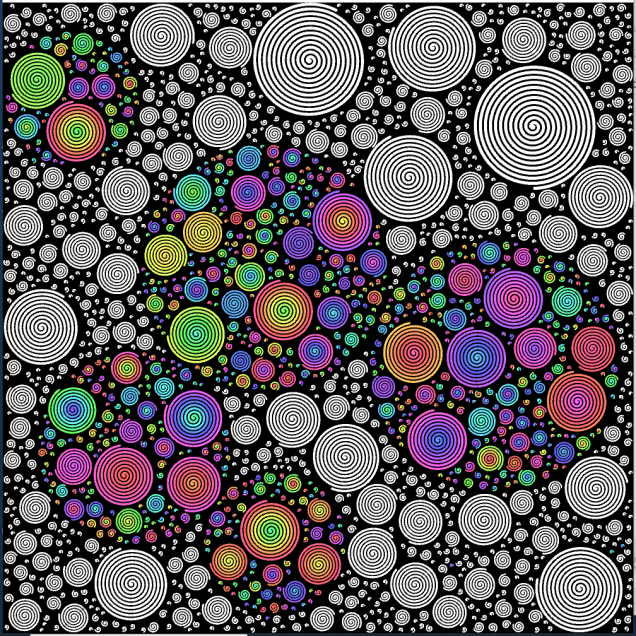
E o meu resultado é o seguinte:

Implementação
Usarei novamento o editor do p5 para essa implementação.
Passo 1
Nesse projeto decidi seguir uma forma simples de reutilizar códigos já feito por outras pessoas ao invés de codificar tudo do zero. É um pouco preguiçoso, mas sempre acho essa uma forma boa de aprender, já que eu sempre busco entender o código dos outros antes de começar a alterar ou incrementar algo.
Para isso, usei como base o código desse vídeo do coding train, onde Daniel Shiffman ensina a aplicar um algoritmo de circle packing. O código do vídeo está nesse projeto que usei como base, fazendo algumas alterações para utilizar o canvas inteiro ao invés de uma imagem.
Esse é o código após as alterações:
1 | let circles = [] |
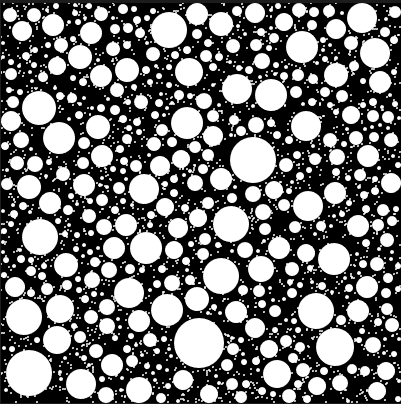
Passo 2
Meu segundo passo foi alterar o código para desenhar espirais ao invés de círculos. Pedi para o ChatGPT criar esse código para mim, e esse foi o resultado:
1 | function drawSpiral(centerX, centerY, radius) { |
Esse código já faz bastante do que queremos, e com um pouco de ajustes podemos subsituír o método show da nossa classe Circle.
1 | class Circle { |
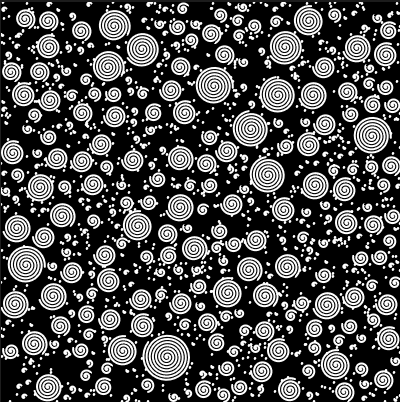
Passo 3
Para adicionarmos cores em alguns dos espirais, teremos que mudar o método show para usar linhas ao invés de vértices, já que a cor irá mudando do início até o fim da espiral.
1 | class Circle { |
Então alteramos o show novamente para adicionar uma cor de stroke aleatória e mudamos o colorMode do nosso projeto para HSB
1 | function setup() { |
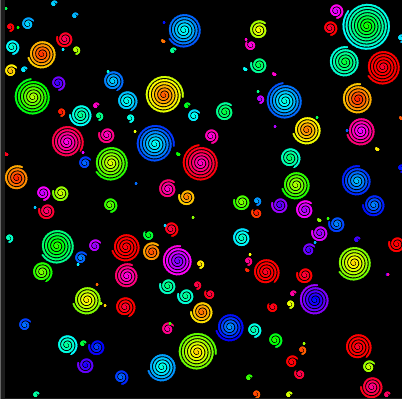
Passo 4
O último passo é definir alguns circulos onde apenas espirais dentro deles serão coloridos. Primeiro geramos a lista de áreas coloridas:
1 | let colorCircles = [] |
Na sequência atualizamos o método grow para atualizar a cor da espiral caso esteja dentro de um dos círculos coloridos.
1 |
|
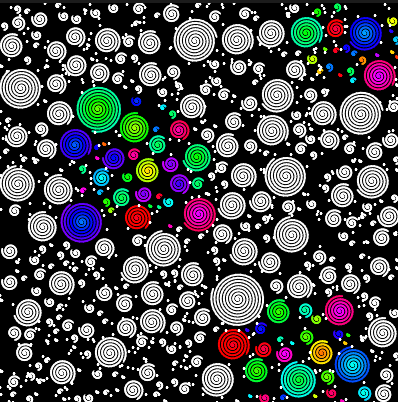
Próximos passos
Como podem ver na imagem base e na final, nossos círculos coloridos não são perfeitos. Isso acontece porque só verificamos se as espirais encostam em uma das áreas coloridas, mas não paramos de crescê-las quando elas ultrapassam.
Uma ideia para brincar mais um pouco com esse código seria adicionar essa validação para que não sejam desenhadas espirais entre as áreas coloridas e preto e brancas.
Código completo
1
2
3
4
5
6
7
8
9
10
11
12
13
14
15
16
17
18
19
20
21
22
23
24
25
26
27
28
29
30
31
32
33
34
35
36
37
38
39
40
41
42
43
44
45
46
47
48
49
50
51
52
53
54
55
56
57
58
59
60
61
62
63
64
65
66
67
68
69
70
71
72
73
74
75
76
77
78
79
80
81
82
83
84
85
86
87
88
89
90
91
92
93
94
95
96
97
98
99
100
101
102
103
104
105
106
107
108
109
110
111
112
113
114
115
116
117
118
119
120
121
122
123
124
125
126
127
128
129
130
131
132
133
134
135
136
137
138
139
140
141
142
143
144
145
146
147
148
149
150
151
152
153
154
155
156
157
158
159
160
161
162
163
164
165
166
167let circles = []
let spots = []
let colorCircles = []
function setup() {
createCanvas(400, 400)
colorMode(HSB)
for (let x = 0; x < width; x++) {
for (let y = 0; y < height; y++) {
spots.push(createVector(x, y))
}
}
for (let i = 0; i < 3; i++) {
colorCircles.push({
x: random(0, width),
y: random(0, height),
r: 30
})
}
}
function draw() {
background(0)
let total = 5
let count = 0
let attempts = 0
while (count < total) {
let newC = newCircle()
if (newC !== null) {
circles.push(newC)
count++
}
attempts++
if (attempts > 1000) {
noLoop()
break
}
}
for (let i = 0; i < circles.length; i++) {
let circl = circles[i]
if (circl.growing) {
if (circl.edges()) {
circl.growing = false
} else {
for (let j = 0; j < circles.length; j++) {
let other = circles[j]
if (circl !== other) {
var d = dist(circl.x, circl.y, other.x, other.y)
var distance = circl.r + other.r
if (d - 4 < distance) {
circl.growing = false
break
}
}
}
}
}
circl.show()
circl.grow()
}
}
function newCircle() {
var r = int(random(0, spots.length))
var spot = spots[r]
spots.splice(r, 1)
var x = spot.x
var y = spot.y
var valid = true
for (var i = 0; i < circles.length; i++) {
var circle = circles[i]
var d = dist(x, y, circle.x, circle.y)
if (d < circle.r) {
valid = false
break
}
}
if (valid) {
return new Circle(x, y)
} else {
return null
}
}
class Circle {
constructor(x, y) {
this.x = x
this.y = y
this.r = 1
this.growing = true
}
isColored() {
for (let i = 0; i < colorCircles.length; i++) {
const other = colorCircles[i]
var d = dist(this.x, this.y, other.x, other.y)
var distance = this.r + other.r
if (d - 4 < distance) {
this.colorRange = random(0, 360)
}
}
}
grow() {
if (this.growing) {
this.r += 1
if (this.colorRange > 0) return
for (let i = 0; i < colorCircles.length; i++) {
const other = colorCircles[i]
var d = dist(this.x, this.y, other.x, other.y);
var distance = this.r + other.r * 2;
if (d - 4 < distance) {
this.colorRange = random(0, 360)
}
}
}
}
show() {
let angle = 0
let increment = 0.2
noFill()
stroke(255)
strokeWeight(2)
let prev
for (let r = 0; r < this.r; r += 0.1) {
let x = this.x + cos(angle) * r
let y = this.y + sin(angle) * r
if (this.colorRange === 0) {
stroke(255);
} else {
stroke(r * 3 + this.colorRange, height, height);
}
if (prev) {
line(prev.x, prev.y, x, y)
} else {
point(x, y)
}
prev = createVector(x, y)
angle += increment
}
}
edges() {
return (
this.x + this.r >= width ||
this.x - this.r <= 0 ||
this.y + this.r >= height ||
this.y - this.r <= 0
)
}
}